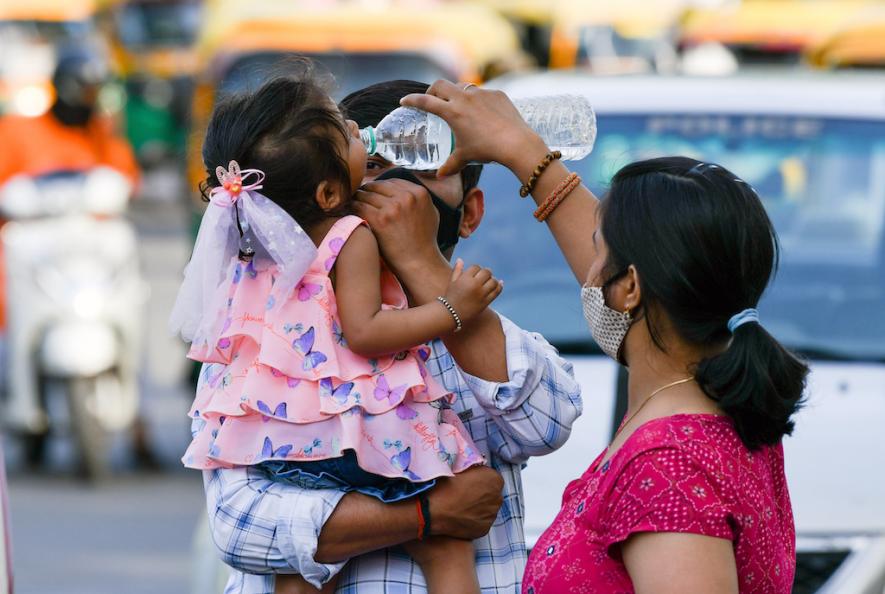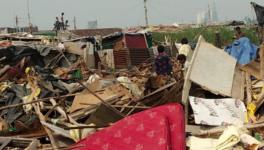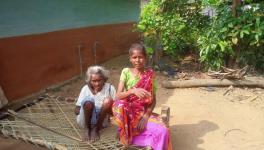Heatwaves Continue To be Hotter and More Dangerous due to Climate Change

Apr 03 (ANI): A woman gives water to her child in respite from the heatwave on a hot summer day, in New Delhi on Sunday.
While the temperatures in South Asia are likely to be the most extreme this week, the subcontinent is not the only place being hurt by heat right now. In Argentina and Paraguay, there is an exceptional heatwave. The temperature is set to reach 40 degrees Celsius in Paraguay today, along with a heatwave up to 38 degrees C in China, and 36 degrees C in Turkey and Cyprus. As emissions drive further heating, these dangerous extremes are likely to become more common.
India has already suffered the hottest March in 122 years of weather data, and parts of the country are seeing wheat yields drop by 10-35% due to the unseasonal heat even as the country tries to make up the shortfall caused by the Russian invasion of Ukraine.
A new analysis by Dr Mariam Zachariah and Dr Friederike Otto, Imperial College London, found that the heat that hit India earlier this month is already much more common as a result of higher global temperatures caused by human activities.
Dr Zachariah is a research associate at the Grantham Institute, Imperial College London, and Dr Friederike Otto is a senior lecturer in Climate Science at the Grantham Institute, Imperial College, London. He also leads the World Weather Attribution group and was named one of Time Magazine’s most influential people of 2021.
The scientists also talked about India’s neighbouring country Pakistan in the same context. They are of the view that the temperatures are forecast to rise to 50 degrees C in Pakistan’s Jacobabad, which is approaching the temperature record for the city - one of the hottest places on the planet. For India’s capital, New Delhi, the estimation for April temperature is to go up to 44-45°C as the city is approaching its record April temperature.
The new analysis by climate scientists has directly connected the heatwaves with climate change.
“The recent high temperatures in India were made more likely by climate change. Before human activities increased global temperatures, we would have seen the heat that hit India earlier this month around once in 50 years. But now it is a much more common event - we can expect such high temperatures about once in every four years. And until net emissions are halted, it will continue to become even more common," Zachariah said.
Otto’s views have been that “India's current heatwave has been made hotter by climate change that is the result of human activities like burning coal and other fossil fuels. This is now the case for every heatwave, everywhere in the world. Until net greenhouse gas emissions end, heatwaves in India and elsewhere will continue to become hotter and more dangerous."
Some experts in India are also stressing the need for actions to help people survive the climate change-driven extreme heatwaves.
Abhiyant Tiwari , assistant professor and program manager, Gujarat Institute of Disaster Management, said, “While taking mitigation measures is a must to limit future warming, the extreme, frequent, and long-lasting spells of heatwaves are no more a future risk. It is already here and is unavoidable.” He further added, “Our heat action plans must ensure adaptation measures like public cooling areas, ensuring uninterrupted electricity, access to safe drinking water, and changing the work hours of labourers for the most vulnerable ones at the bottom of the pyramid, especially during extreme heat days."
The forecast temperatures are similar to those seen in the deadly heatwaves that hit India and Pakistan in May/June 2015, which killed at least 4,500 people. In the deadly June 2015 heatwave, New Delhi airport reached 44.6°C, while the hottest temperatures in India were seen in Jharsuguda, Odisha at 49.4°C.
Heatwave warnings have been issued, with public health experts warning that extreme heat so early in the year is particularly dangerous.
Dileep Mavalankar, Director, Indian Institute of Public Health, Gandhinagar, said, “The Indian Meteorological Department (IMD) is releasing forecast advisories for up to the next five days for 1000 cities in India. Ahmedabad is on an orange alert on all the days with temperatures ranging between 43-44°C and this may increase further.”
He said people need to watch out for these advisories, stay indoors, keep themselves hydrated, and rush to the nearest health centre if they feel moderate signs of heat-related illness. There's a special need to monitor the old and vulnerable, just like we did during COVID as they can develop heat strokes even when sitting at home.
He advised cities administration to monitor all-cause mortality data daily along with data for hospital admissions and ambulance calls to compare it with the last five years of data to get a real indication of heat stress on mortality.
States like West Bengal and Odisha have also begun taking precautionary measures to protect citizens from the rising heatwave. In West Bengal, the local government has advised schools to shift classes to the cooler morning hours and stock up on oral rehydration salts, in case of children become sick. Some schools are even moving classes online, so children don’t have to venture outside in blistering conditions.
Meanwhile, the government is also mulling starting an early summer vacation in schools to provide relief to the students from the blazing heat, said West Bengal education minister Bratya Basu.
The West Bengal Council of Higher Secondary Education also asked its schools to ensure uninterrupted power and water supply, adequate availability of ORS (oral rehydration therapy) and medical facility for the board level students
Meanwhile, in Odisha, higher education classes have been stopped completely.
"Due to Northwesterly-Westerly dry air and high solar insolation Maximum temperature (Day Temperature) is very likely to gradually rise by 3 to 5°C at many places over the districts of interior Odisha during next 3 days and no large change thereafter over the districts of Odisha," Bhubaneswar’s Meteorological Centre said in a release. "Consequently maximum temperature (Day Temperature) likely to be more than 40°C at many places over the districts of Odisha and likely to be above normal by 2 to 4°C during next 2 days over the districts of Odisha and likely to be above normal by 3 to 5°C over the districts of Interior Odisha in subsequent 3 days,” it added.
Mavalankar further said, “This is a very early heatwave and these normally have a higher rate of mortality since adaptation and preparedness are lower during these months of March and April. The central, state, and city governments should also focus on this, especially when IMD alerts are in orange and red and they should put out warning advertisements in newspapers, TV and radio to warn the public. This is a warning signal for what is to come in May and June. If we take effective action now we can prevent a lot of morbidity and mortality".
The writer is a freelance journalist.
Get the latest reports & analysis with people's perspective on Protests, movements & deep analytical videos, discussions of the current affairs in your Telegram app. Subscribe to NewsClick's Telegram channel & get Real-Time updates on stories, as they get published on our website.
























